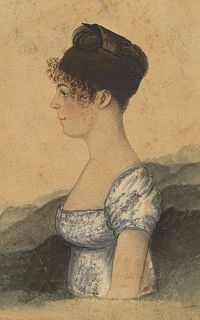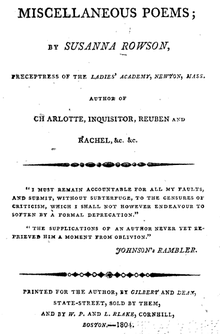- Susanna Rowson
-
Susanna Rowson, née Haswell (1762–1824) was a British-American novelist, poet, playwright, religious writer, stage actress and educator.
Rowson was the author of the novel Charlotte Temple, the most popular best-seller in American literature until Harriet Beecher Stowe's Uncle Tom's Cabin was published in 1852.
Contents
Biography
Childhood
Susanna Haswell was born in 1762 in Portsmouth, England to Royal Navy Lieutenant William Haswell and his first wife, Susanna Musgrave, who died within days of her birth. Her father was stationed in Boston as a customs officer, and there married Rachel Woodward, returning to England to bring his daughter to Massachusetts. On arrival in 1767, their ship grounded on Lovells Island in Boston Harbor, the crew and passengers being rescued from the wreck days later. They lived at Hull, where family friend James Otis took a special interest in her education. At the outbreak of the American Revolution, the father was placed under house arrest, and subsequently the family was moved inland, to Hingham and Abington, Massachusetts. In 1778, the failing health of Lieutenant Haswell led to a prisoner exchange, and the family was sent via Halifax, Nova Scotia to England, settling near Kingston upon Hull. Their American property having been confiscated, they lived in relative poverty, Susanna helping to support the family by serving as a governess.
Pen and stage
It was as governess that she wrote her first work, Victoria, dedicated to the Duchess of Devonshire, published in 1786, and in the same year she married William Rowson, a hardware merchant and horse guards trumpeter. In 1791, she published the novel now referred to as Charlotte Temple; it became the first American best-selling novel.[1] After William's hardware business failed, he and Susanna turned to acting.[2] In 1793, as a member of the theater company of Thomas Wignell, she returned to America, performing in Philadelphia.
Over the next three years there she wrote a novel, an opera, a musical farce about the Whiskey Rebellion (The Volunteers), a poetical address to the American troops, and several songs for the company in addition to performing 57 roles on the stage in two seasons. In response to her seemingly new-found republicanism and the liberal gender roles in her work, Slaves in Algiers, she was attacked by William Cobbett who referred to her as "our American Sappho" (she returned fire, calling him a "loathsome reptile" in her introduction to Trials of the Human Heart).[3] In 1796, she and Rowson removed to Boston, performing at the Federal Street Theatre.
Later years
The next year, she gave up the stage, and founded a boarding school for girls, which she would later move to Medford and Newton, returning to Boston in 1809 and training hundreds of girls. She also continued her writings, producing several novels, an additional work for the stage, a dictionary and two geographies as well as being editor of the Boston Weekly Magazine (1802–1805). She was also called on to support her husband, and (though they had no children of their own) an increasingly growing household including her husband's illegitimate son, two adopted daughters, and the widow and daughters of her half-brother Robert Haswell who had been lost at sea in 1801. (One of these nieces, Rebecca Haswell, was great-grandmother of poet E. E. Cummings.) She also headed a charity for widows and the fatherless. She retired from her school in 1822, and died in Boston two years later, March 2, 1824. She was buried in the family vault of friend Gottlieb Graupner at St. Matthew's Church, South Boston. When this church was demolished in 1866, her remains could not be distinguished, and all remains were moved together to the Mount Hope Cemetery, Boston. A monument was later raised for Susanna Rowson and brothers Robert and John Montresor Haswell in Forest Hills Cemetery in Boston's Jamaica Plain neighbourhood, where she is memorialized as the author of Charlotte Temple.
Works
Fiction
- Victoria (1786)
- The Inquisitor (1788)
- Mary, or, The Test of Honour (1789)
- Charlotte: a Tale of Truth (1790; retitled Charlotte Temple after the 3rd American edition, 1797)
- Mentoria (1791)
- Rebecca, or, The Fille de Chambre (1792)
- Trials of the Human Heart (1795)
- Reuben and Rachel (1798)
- Sarah (1813)
- Charlotte's Daughter, or, The Three Orphans (a sequel to Charlotte's Temple published posthumously in 1828, with a memoir by Samuel L. Knapp; also known as Lucy Temple)
Plays
- Slaves of Algiers; or, A Struggle for Freedom (1794)[4]
- The Female Patriot (1795)[4]
- The Volunteers (1795)[4]
- Americans in England (1796; retitled Columbian Daughters for 1800 production)
- The American Tar (1796)
- Hearts of Oak (1811)
Verse
- Poems of Various Subjects (1788)
- A Trip to Parnassus (1788)
- The Standard of Liberty (1795)
- Miscellaneous Poems (1811)
Other
- An Abridgement of Universal Geography (1805)
- A Spelling Dictionary (1807)
- A Present for Young Ladies (1811)
- Youth's first Step in Geography (1811)
- Biblical Dialogues Between a Father and His Family (1822)
- Exercises in History, Chronology, and Biography, in Question and Answer (1822)
References
- ^ Watts, Emily Stipes. The Poetry of American Women from 1632 to 1945. Austin, Texas: University of Texas Press, 1978: 56. ISBN 0-292-76540-2
- ^ Rowson, Susanna. Charlotte Temple (ed. Clara M. and Rudolf Kirk). New Haven, Connecticut: Twayne Publishers, 1964: 13.
- ^ Cobbett, in the character of Peter Porcupine, would write of her works, "A liquorish page from Fille de Chambre serves me by way of a philtre; the Inquisitor is my opium, and I have ever found the Slaves of Algiers a most excellent emetic." (Nason, A Memoir . . ., p. 85)
- ^ a b c Watts, Emily Stipes. The Poetry of American Women from 1632 to 1945. Austin, Texas: University of Texas Press, 1978: 57. ISBN 0-292-76540-2
Further reading
- Davidson, Cathy N., edited with an introduction by, Charlotte Temple – Susanna Rowson (Oxford, c1987).
- Homestead, Melissa J., and Camryn Hansen. (2010). Susanna Rowson's Transatlantic Career. Early American Literature, 45:3, 619–654.
- Kornfeld, Eve. (1983). Women in Post-Revolutionary American Culture: Susanna Haswell Rowson's American Career, 1793–1824. Journal of American Culture, 6:4, 56–62.
- Nason, Elias. (1870). A Memoir of Mrs. Susanna Rowson. Albany, NY: J. Munsell.
- Parker, Patricia L. (1986). Susanna Rowson. Boston: Twayne Publishers.
- Rust, Marion, Prodigal Daughters – Susanna Rowson's Early American Women (The University of North Carolina Press, c2008).
- Vinson, James, ed. (1979). Great Writers of the English Language: Novelists and Prose Writers. New York: St. Martin's Press. pp. 1046–1048.
External links
- Laraine Fergenson, 'Susanna Haswell Rowson (1762–1824)', Heath Anthology of American Literature
- Works by Susanna Rowson at Project Gutenberg
Categories:- 1762 births
- 1824 deaths
- People from Portsmouth
- People from Boston, Massachusetts
- British novelists
- American novelists
- British women writers
- American women writers
- Novels by Susanna Rowson
Wikimedia Foundation. 2010.




